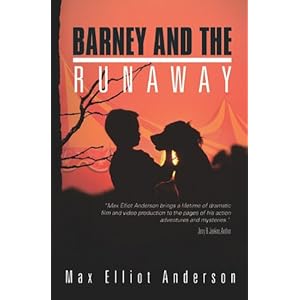Rather than focusing on that discussion (which I'll save for another post) in this review, I'm simply going to review this particular book.
Max Elliot Anderson was a struggling and reluctant reader when he was growing up. His work experience is in the fields of motion pictures, videos, and commercials. He has written several books and Barney and the Runaway is his most recent. Here's a trailer for the book:
Storyline: The story is about a boy, Mike, who runs away because he doesn't like the rules in the house. He and his dog, Barney (who I pictured to be much smaller in the book than is shown in the trailer), get trapped on a railroad car traveling southeast. When the train stops, they discover that they have been on a circus train and have traveled quite a distance from home. Big Bob is a circus clown who takes Mike and Barney in. And the story goes from there...
Strengths: The book moves at a good pace and flows well for the most part. Readers are put in the driver's seat to imagine what everything looks like. The book is a very fast read with simple language and sentence structure. My husband felt it was a very competent book. I asked his opinion since I happen to be a woman and not a man. He felt it would be a very easy read for a child who is used to watching television and video games rather than reading books.
Weaknesses: This book is written at a 2nd or 3rd grade reading level, in my opinion. It has as much description as Dori Hillestad Butler's The Buddy Files series. Whereas, I felt the description was appropriate in The Buddy Files series, that is a weakness to me in this book because I would want even reluctant readers to learn to comprehend writing that is more detailed and specific. This book (as you can see by the trailer) is really set in the 1950s or 1960s rather than today. That isn't specified in the book. There were also several points in the story that were very stilted to me. For example, I wasn't sure how he got home in the first chapter of the book.
Best Audience for this Book: This book would be great for a child that is used to watching television and isn't used to a lot of descriptive language in a book. It is written like a movie script without illustrations.
My conclusions...
Is this a book you could hand your child and not worry about? Yes. So, if you are of the mind that you just want your child to read and just want to make sure there isn't anything in the content to be concerned about, then this book would be fine.
Is this a book I would recommend across the board? Well...what we read becomes our model for how and what we write. We want to read good examples of writing with description and good sentence structure because it helps us become better writers. Reading helps our children learn how to write, how to spell, and even how to speak. In education theory, there is an idea explained by Vygotsky about scaffolding. We want children to read a step or two above where they're at. We don't want them to get frustrated, but we do want them to be challenged. This book is written at a 3rd grade reading level for readers 8-13 years old. I think it would be appropriate reading for a 3rd, 4th, or 5th grade boy who is a reluctant reader. If a boy is in middle school, they will need more examples of description so that their own writing can improve and they can grow in their ability to complete their school assignments. This book is what I think a middle school boy might write. That is fine. But, by Vygotsky's theory, you want them to read a step or two above that. The book I received in the mail today from the Christian Heroes: Then & Now series is a good example of that step above for a middle school reader.
Please note that I received a complimentary copy of this book from Comfort Publishing for review.

No comments:
Post a Comment